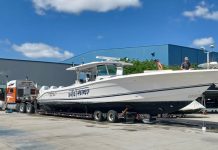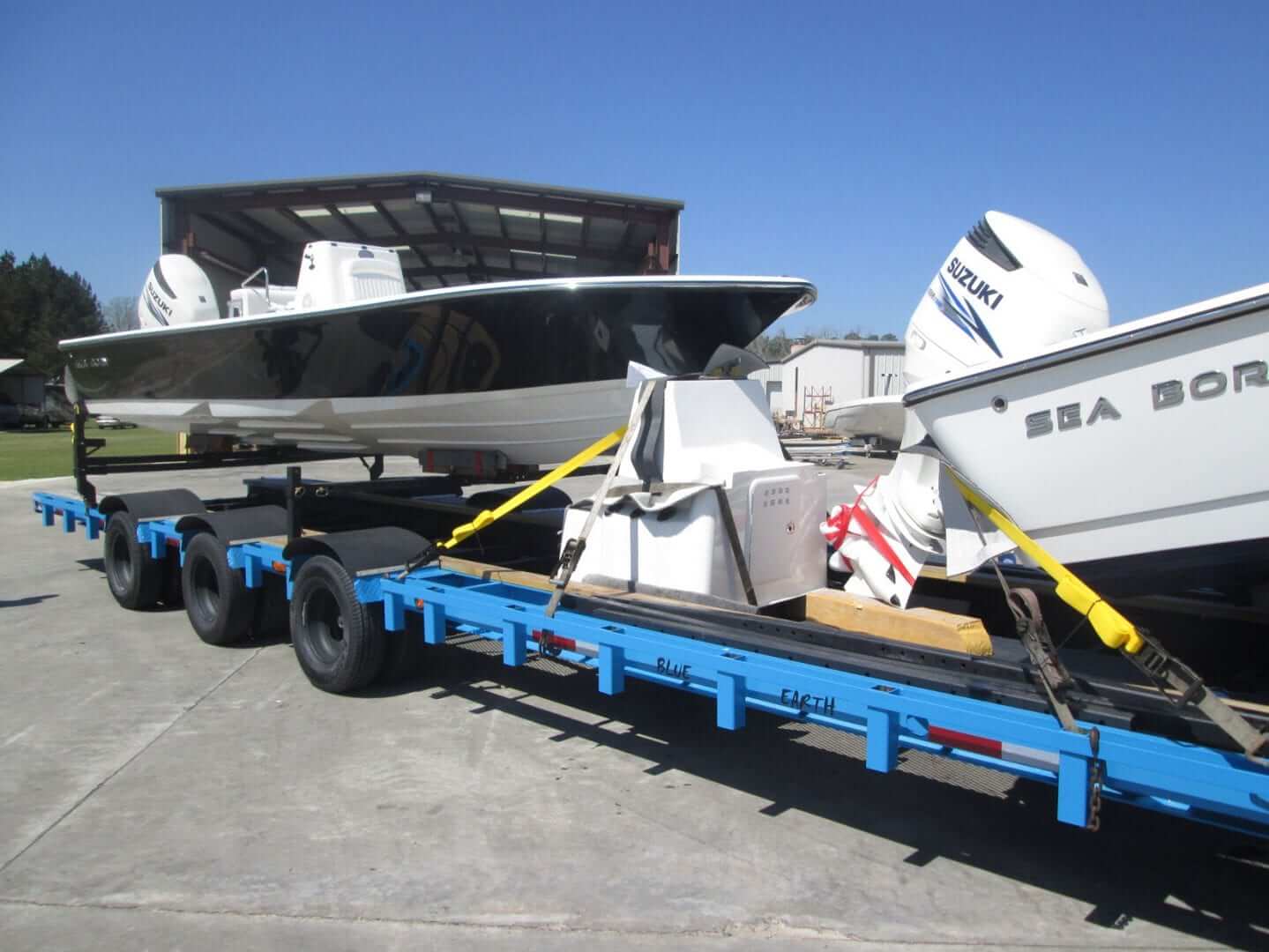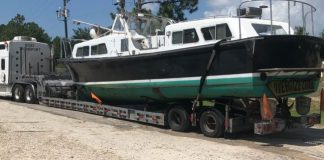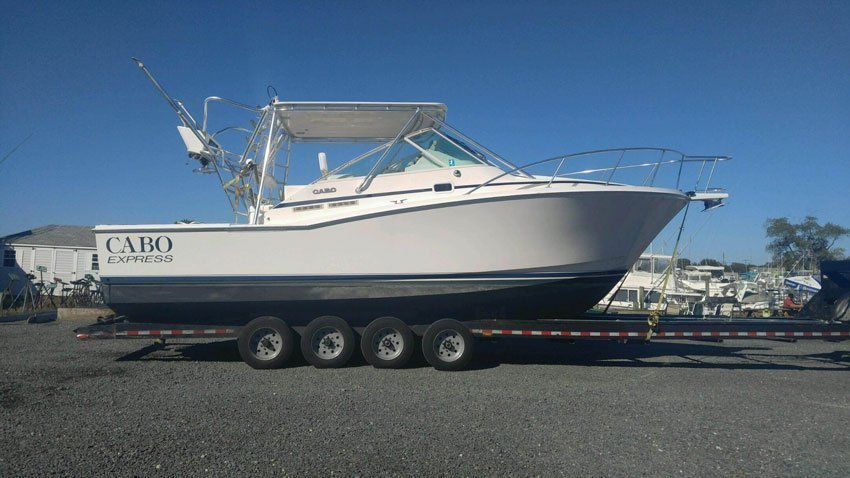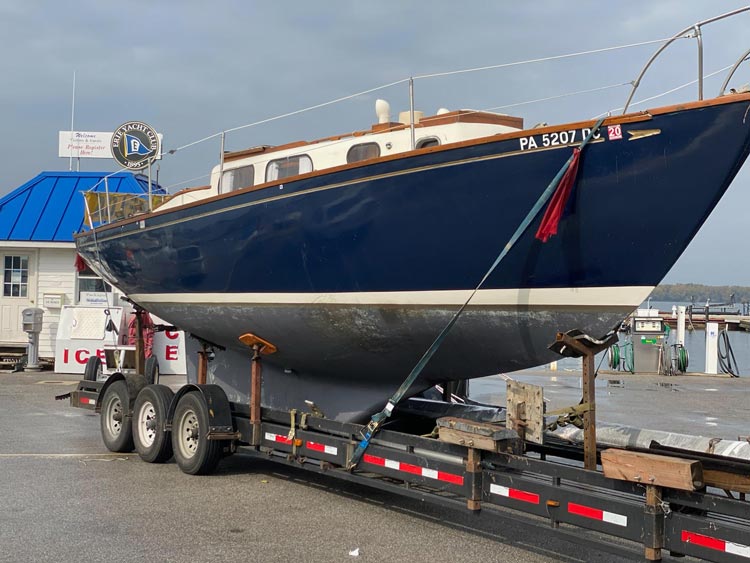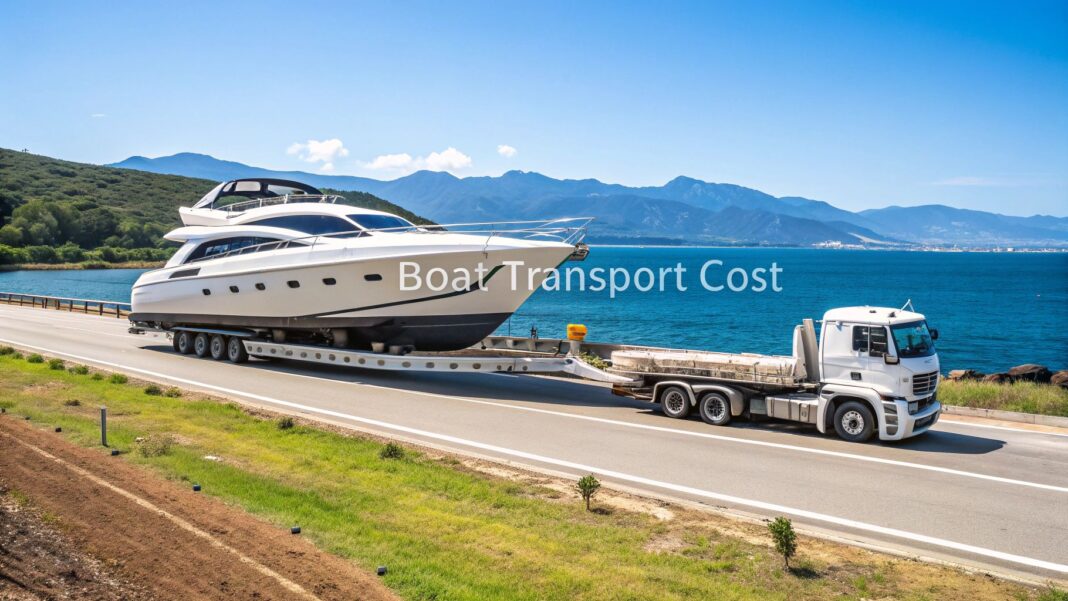
When you’re looking to ship a boat, the first number you’ll likely hear is a per-mile rate. Generally, you can expect to pay somewhere between $1.50 and $3.75 per mile for overland transport. That means a 1,000-mile trip could run you anywhere from $1,500 to over $3,750, but that’s just the starting point.
The final price tag depends on a lot more than just the miles on a map.
Your Guide to Boat Transport Costs

Figuring out the cost of moving your boat can feel murky, but it really boils down to a few key variables. Think of it like this: hauling a small, 18-foot fishing boat that’s already on its own trailer is a straightforward, budget-friendly move. On the other hand, a 45-foot yacht with a wide beam is a different beast entirely. That job demands a specialized lowboy trailer, permits for every state it passes through, and often pilot cars to safely escort it down the highway.
Understanding what drives these costs is the first step to creating an accurate budget and making smart decisions.
Estimated Boat Transport Costs At a Glance
This table provides a realistic idea of costs for common scenarios. Use it as a starting point, but remember your specific quote will depend on the factors we discuss next.
| Transport Method | Typical Distance | Average Cost Range | Key Cost Drivers |
|---|---|---|---|
| Owner’s Trailer (Tow & Go) | 500 miles | $500 – $1,250 | Fuel, insurance, potential tire/bearing service |
| Professional Hauler | 1,000 miles | $1,500 – $3,750 | Dimensions, permits, fuel surcharge |
| Oversize Load (Yacht) | 1,500 miles | $4,500 – $10,000+ | Permits, pilot cars, route surveys, crane fees |
| Captain Delivery (Water) | 300 nautical miles | $2,000 – $5,000 (plus fuel) | Captain/crew daily rate, fuel, marina fees, provisions |
These figures help set a baseline, but the devil is truly in the details. Let’s break down what really drives your final cost.
The Core Factors Influencing Your Quote
To budget accurately, you have to understand what makes the price go up or down. Every transport company will build your quote around these four primary elements:
- Boat Dimensions: The single biggest factor. Your boat’s length, width (beam), height, and weight determine the type of trailer, permits, and even the route. Once you cross into “oversize” territory (typically over 8’6″ wide or 13’6″ high on the trailer), costs rise significantly.
- Total Distance and Route: While the cost-per-mile can sometimes drop on a very long haul, the total price obviously goes up with distance. The route itself matters, too—navigating tricky mountain passes, dense city traffic, or avoiding low bridges can add time and expense.
- Transport Method: How your boat gets there is a huge piece of the puzzle. The cost to have it hauled overland on a truck is completely different from hiring a captain to sail it or shipping it as ocean freight.
- Seasonal Demand: Just like with vacation rentals, there’s a peak season. Transporters are swamped in the spring (moving boats north) and fall (moving boats south). Booking during these high-demand periods will almost always cost you a premium.
Actionable Insight: Getting a handle on how these pieces fit together is key. It moves you from just getting a price to actually understanding the logistics and value behind it. This knowledge helps you ask the right questions and find the smartest, most efficient way to get your boat where it needs to go.
Throughout this guide, we’ll provide real-world examples and practical tips to help you navigate the process, sidestep hidden fees, and make sure your boat arrives at its new home safe and sound—without sinking your budget.
How Your Boat’s Size and Travel Distance Drive the Final Price
When you get a quote to move your boat, two things will always stand out as the biggest cost drivers: the size of your vessel and how far it needs to go. These factors work together to determine the complexity, equipment, and ultimately, the expense of the job.
This breakdown shows you how these core factors build the foundation for your total transport cost.

As you can see, everything from permits to the type of truck needed flows directly from your boat’s dimensions, the journey’s length, and the shipping method you choose.
Why Every Inch and Pound Matters
Your boat’s specs—length, beam (its width), height, and weight—are the DNA of your transport quote. A longer boat obviously needs a longer trailer, but it’s often the beam and height that cause the price to jump significantly.
Most states have a legal width limit of 8 feet 6 inches for a standard load. The second your boat’s beam crosses that line, it’s reclassified as an “oversize” or “wide load.” This is a crucial distinction, as it triggers a new set of rules and costs, including state-specific permits and travel time restrictions.
The same applies to height. Once your boat sits taller than 13 feet 6 inches on the trailer, it demands special permits and, more critically, a carefully planned route to dodge low bridges, overpasses, and power lines. This isn’t just a suggestion; it’s a non-negotiable legal and safety requirement.
Actionable Insight: A boat that’s nine feet wide will always cost more to ship than an eight-foot-wide boat, even if they’re the same length and weight, and going to the same place. That extra foot pushes it into a different regulatory league, instantly adding costs for permits and potentially pilot cars.
The Dynamics of Distance and Per-Mile Rates
The cost-per-mile is not always straightforward. For shorter hauls, the per-mile rate is often higher. That’s because fixed costs—like loading, securing the boat, and initial permit fees—get spread out over fewer miles.
Conversely, for a long-haul, cross-country trip, the per-mile rate can actually drop as the trucker gains efficiency on open highways. However, the total bill will naturally be much larger than for a local move. Fuel surcharges, which fluctuate with diesel prices, will also be a more significant factor on longer journeys.
Choosing Your Transport Method
The way your boat travels is a major factor affecting the cost to transport a boat. Each method has a distinct price structure and is suited for different boats and journeys.
- Overland Trucking: This is the most common and cost-effective method for domestic moves. Your boat is loaded onto a specialized trailer and hauled by road. It’s direct and works for the vast majority of recreational boats.
- Captain-for-Hire (On-Water Delivery): A viable option for large yachts or coastal moves. You avoid road permits, but costs shift to the captain’s daily rate, crew wages, fuel, provisions, and marina slip fees. Critically, this method adds operational hours and wear and tear to your boat’s engines and systems.
- International Ocean Freight: The only choice for crossing an ocean. Your boat can be shipped via Lift-on/Lift-off (LoLo), where a crane loads it onto a cargo ship, or Roll-on/Roll-off (RoRo), where it’s towed onto the vessel on a cradle. Both are logistically complex and involve significant port fees, customs paperwork, and freight charges.
Let’s compare them side-by-side for a clearer picture.
| Feature | Overland Trucking | Captain-for-Hire | Ocean Freight (LoLo/RoRo) |
|---|---|---|---|
| Best For | Domestic moves, boats up to ~50 feet | Large yachts, coastal moves, short sea routes | International and trans-oceanic journeys |
| Primary Costs | Per-mile rate, permits, pilot cars (if oversize), fuel surcharge | Captain/crew fees, fuel, marina fees, provisions, insurance | Freight rate, port fees, customs, crating, destination charges |
| Key Advantage | Speed and cost-effectiveness for land routes | No disassembly, handles oversized yachts | Only option for overseas transport |
| Key Disadvantage | Size limitations, potential need for disassembly | Engine wear, weather delays, slower, variable final cost | High cost, complex logistics, port delays, market volatility |
Ultimately, understanding how your boat’s size, the distance, and the shipping method interact is the first step to creating a realistic budget. An extra foot of width can easily have a bigger impact on your bill than an extra hundred miles of road. Choosing the right method from the get-go puts you on the most cost-effective path for your specific move.
Uncovering the Hidden Costs of Boat Transport
The initial quote you receive is a great starting point, but it’s rarely the full picture. Getting a handle on potential add-ons right from the start is the only way to build a realistic budget and avoid surprises on the final bill.

Most of these extra costs aren’t hidden fees; they are for essential services that ensure a safe, legal, and damage-free move. From prepping your boat for the highway to ensuring it’s properly insured, these details make the difference.
Essential Boat Preparation Services
Before your boat is loaded onto a trailer, it needs proper preparation. While some owners DIY this process, many hire professionals to ensure it’s done correctly. These services are almost never included in a standard shipping quote.
- Shrink-Wrapping: This is essential to protect your boat from road grime, debris, and weather. Professional shrink-wrapping costs between $10 to $25 per linear foot. To learn more, check our guide on shrink-wrapping a boat for transport.
- Winterizing: If your boat is moving through or to a cold climate, winterizing is non-negotiable to protect the engine and plumbing from freezing and cracking. Expect to pay $150 to $500, depending on the complexity of your boat’s systems.
Lifting and Loading Fees
Getting a boat out of the water and onto a transport truck requires a Travelift or crane, and marinas charge for this service. These lift fees can add significantly to your total cost.
You will face these fees at both the pickup and drop-off locations. Actionable Insight: Budget $150 to $600 for each lift. Call both marinas ahead of time to confirm their prices and equipment capabilities so you aren’t caught off guard.
Actionable Insight: Don’t just assume your transport company’s insurance is enough. A carrier’s liability insurance is designed to protect them. Always review your own marine policy or get a separate transit policy for complete peace of mind. Confirm that their policy covers the full declared value of your vessel.
The Critical Role of Insurance
This is one of the most overlooked costs, and cutting corners here is a major risk. While every legitimate transporter has liability and cargo insurance, their coverage limits might be below your boat’s actual value.
A separate trip transit insurance policy ensures your investment is fully protected against road hazards. The cost is typically around 1-2% of your boat’s insured value—a small price for knowing you’re completely covered against damage or a total loss.
How Seasonality Affects Your Wallet
Timing is everything when you ship a boat. The cost to transport a boat fluctuates based on seasonal demand.
The busiest seasons are spring (March-May) and fall (September-November). This is when “snowbirds” move their boats south for the winter or back north for the summer. With high demand, carriers can charge a premium—often 15-30% higher than their off-season rates.
Conversely, you can find significant savings if you schedule your move during the off-season. In mid-summer (June-August) or the dead of winter (December-February), transporters are looking to fill their schedules and are more competitive with their pricing, giving you more negotiating power.
Navigating International Boat Shipping and Market Changes
Moving a boat across an ocean is a whole different ball game. The cost to transport a boat internationally is tied to volatile global market forces that can shift without warning. It’s less about a fixed schedule and more about strategic timing.
Think of international ocean freight as a stock market for space on a ship. Geopolitical tensions, port backlogs, or global supply chain issues—things that have nothing to do with your boat—can send prices soaring.
Why Global Events Shake Up Shipping Rates
The world’s shipping lanes are an interconnected system. When a major disruption occurs, like a conflict or blockage, it creates ripples everywhere, causing delays and price hikes.
Carriers may have to take longer, more expensive routes, burning more fuel and adding weeks to the trip. These extra costs are passed directly to you. For example, in 2025, freight rates skyrocketed due to disruptions in the Red Sea. The cost to move a container from Shanghai to Rotterdam jumped from around $1,800 in early 2024 to over $6,000 by mid-2025—a more than 230% increase. This volatility directly impacts the cost of shipping a boat.
Actionable Insight: For international transport, flexibility is your greatest asset. Having a contingency fund and a generous delivery timeline aren’t just good ideas—they are essential for a successful move.
How to Plan When the Market is a Moving Target
Budgeting for such an unpredictable market requires a smart approach. You can’t get a rock-solid quote months in advance like a domestic move.
First, partner with an experienced logistics provider. They monitor the market and can provide invaluable advice on when to ship. For a deeper look, our guide on shipping boats overseas outlines the specific steps.
Second, be prepared to act quickly. When your logistics expert identifies a favorable shipping window, you need to be ready to book it. Hesitating can mean missing the opportunity.
Finally, understand the shipping methods and their cost implications:
- Roll-On/Roll-Off (RoRo): Typically the most economical option. Your boat is towed onto the vessel on its trailer or a shipping cradle. It’s straightforward with minimal handling.
- Lift-On/Lift-Off (LoLo): A crane lifts your boat onto the cargo ship’s deck. This is necessary for boats that can’t be rolled on but is more expensive due to the need for specialized equipment.
- Container Shipping: Smaller boats may fit inside a standard shipping container, offering excellent protection. However, this often requires disassembling components like flybridges or arches, adding to preparation costs.
Tackling international boat shipping requires a mindset shift. Focus on understanding market behavior, planning for contingencies, and finding an expert guide. This approach will help you manage risks and make the best decision for your boat’s journey.
Smart Ways to Save Money on Boat Transport
Now that you understand the cost factors, let’s focus on actionable strategies to lower your final bill. With smart planning and some hands-on effort, you can significantly reduce the cost to transport a boat without compromising on safety or professionalism.
Be Flexible With Your Timing
Timing is your secret weapon for savings. The boat transport industry has a peak season in the spring and fall. If you can ship during the off-season—mid-winter or mid-summer—you’ll find companies are much more competitive. When their schedules are light, they are more willing to negotiate a better deal to fill an empty spot on a truck. An open schedule makes you an easy client to work with, which often translates directly into savings.
Get Multiple Quotes From Vetted Professionals
This is a critical step: never accept the first quote you receive. Obtain quotes from at least three to five reputable carriers to understand the market rate for your specific job. This isn’t just about finding the lowest price; it’s about identifying the best value.
- Compare Line Items: Scrutinize what’s included. Does one quote bundle permit fees while another lists them as a separate charge?
- Check Insurance Coverage: Verify the liability and cargo insurance each company provides. Ask for a certificate of insurance and confirm it covers your boat’s value.
- Read Reviews: Look for feedback from customers who shipped a boat similar in size and type to yours. Their real-world experience is invaluable.
This process gives you a clear market overview and strong negotiating leverage. For a deeper dive, our guide on how to choose a boat transport service will walk you through vetting carriers like a pro.
Prepare the Boat Yourself
You can pay a marina or the transport company to prep your boat, but doing the work yourself can save hundreds of dollars. Create a checklist: secure loose gear below deck, drain fuel and water tanks, disconnect batteries, and remove personal items. Every task you handle yourself is money that stays in your pocket.
Actionable Insight: The single biggest DIY saving often comes from reducing your boat’s transport dimensions. Taking down antennas, radar arches, and even flybridges can be the difference between a standard load and an expensive oversized one.
Reduce Your Boat’s Transport Dimensions
This is where you can achieve the most significant cost reduction. A boat’s height and width are the biggest drivers of price. If you can remove components to get the vessel under the legal “oversized load” limits (usually 13’6″ high and 8’6″ wide when on the trailer), you eliminate a whole category of expenses.
A standard load avoids the need for:
- Expensive oversized load permits for each state
- Pilot cars to escort the truck
- Complex and lengthy route planning
Removing a radar arch or flybridge requires effort, but the savings can easily run into the thousands, especially on a long-haul trip. Discuss this with your potential transporter first—they can advise which removals will have the biggest impact on the price.
Answering Your Top Questions About Boat Transport Costs

Here are clear, straightforward answers to the questions we hear most often from boat owners. Use this as a quick reference to clear up any final doubts.
How Much Does It Cost to Transport a Boat 1000 Miles?
As a solid rule of thumb, shipping a boat 1000 miles over land will typically cost between $1,500 and $3,750. This is a ballpark figure; the final price depends heavily on your boat’s dimensions. A smaller boat on its own trailer will be at the lower end of that range. If your vessel is wider than 8’6″ or taller than 13’6″ on the trailer, it becomes an oversize load, requiring special permits and pushing the cost toward the higher end of that estimate, or even beyond.
Is It Cheaper to Transport a Boat by Water or Land?
For nearly all domestic moves, overland transport by truck is significantly cheaper and faster. When you hire a captain, you are paying for their daily rate, crew wages, fuel, provisions, and nightly dockage fees, all while adding wear and tear to your boat’s engine. Water transport only becomes a practical consideration for exceptionally large yachts that cannot be moved by road or for short coastal hops between nearby marinas.
The Bottom Line: For domestic moves, trucking is like a direct flight with a fixed ticket price. A captained delivery is the scenic coastal drive with a running tab for all expenses along the way.
Do I Need Special Insurance to Transport My Boat?
Yes, and this is not an area to cut corners. While professional haulers carry cargo and liability insurance, it exists to protect them, and their policy limits may not cover your boat’s full value. First, review your own marine insurance policy to see if it covers overland transport. If it doesn’t, or if the coverage is insufficient, purchasing a separate trip transit insurance policy is a wise investment. It provides peace of mind that your asset is fully protected from dock to dock.
How Do I Prepare My Boat for Transport?
Proper preparation is crucial for a damage-free trip. Your transport company should provide a detailed checklist, but the core tasks include:
- Securing Loose Items: Stow everything that can shift, rattle, or fly off, both on deck and below.
- Draining Fluids: Empty fuel and water tanks to reduce weight and prevent spills.
- Disconnecting Power: Disconnect all batteries and secure the cables away from the terminals.
- Reducing Dimensions: Remove any components that add to the boat’s height or width to avoid oversize fees. This includes antennas, radar domes, propellers, and flagpoles. For larger boats, this may mean removing the flybridge or radar arch.
Proper preparation not only protects your boat but can also directly lower the cost to transport a boat by keeping it within standard legal dimensions.
What Documents Are Needed for Boat Transport?
Having your paperwork in order ensures a smooth handoff. While your transporter will handle all state-level permits, they will need the following from you:
- Proof of Ownership: A copy of the boat’s title or current registration.
- Bill of Sale: Essential if the boat is a new purchase.
- Accurate Boat Specifications: Provide the exact length, beam (width), height, and weight. Inaccurate measurements can lead to incorrect permits and costly delays.
- Photo ID: A copy of your driver’s license for identity verification.
Having these documents ready will prevent delays and ensure the transport process starts without a hitch.
Moving a boat involves a lot of moving parts, but it doesn’t have to be overwhelming. When you want a seamless experience with honest pricing and expert handling, trust the pros at We Will Transport It. Get your free, no-obligation quote today and let us take the weight off your shoulders.



